- The Pitcher Plant (sarracenia purpurea Linnaeus): The Provincial Flower
- The Newfoundland and Labrador Wordmark
- Black Spruce (Picea Mariana): The Provincial Tree
- Atlantic Puffin (Fratercula Arctica): The Provincial Bird
- Willow Ptarmigan (Lagopus lagopus) and Rock Ptargmigan (Lagopus muta): Provincial Game Bird
- The Newfoundland Pony: Provincial Heritage Animal
- The Woodland Caribou: Animal Mascot of the Royal Newfoundland Regiment
- Labradorite: The Provincial Mineral
- Newfoundland and Labrador Tartan: Provincial Tartan
The Pitcher Plant (sarracenia purpurea Linnaeus): The Provincial Flower
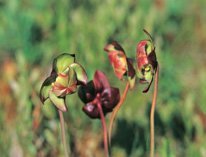
History and Authority
The Pitcher Plant is a carnivorous plant commonly found growing in bogs both in Labrador and on the island of Newfoundland.
It was designated at the provincial flower pursuant to RSNL 1990 Chapter F-20, the Floral Emblem Act.
The Newfoundland and Labrador Wordmark

History and Authority
Wordmark of the Government of Newfoundland and Labrador, adopted 2006. The flowers are stylized pitcher plants.
Usage and Practical Application
Standards for use of the NL Wordmark are established in the Graphic Standards Manual.
For permission to use the wordmark, please contact the Communications Branch, Executive Council, Confederation Building, P.O. Box 8700, St. John’s, NL A1B 4J6.
Black Spruce (Picea Mariana): The Provincial Tree
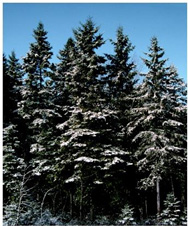
History and Authority
Also known as the bog spruce. Though dark bluish-green in colour, it is called the “black” spruce to distinguish it from other types of spruce trees. A coniferous evergreen, it tolerates nutrient-deficient soils, growing well in areas with poor drainage. It is the most abundant tree in Labrador and appears on the Labrador flag. In North America, it grows as far north as Alaska and as far south as Massachusetts.
Designated Provincial Tree in November 1993. The tree is most characteristic of the boreal forests of Newfoundland and Labrador.
Atlantic Puffin (Fratercula Arctica): The Provincial Bird
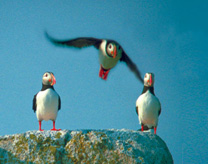
History and Authority
With a thick orange, yellow, and grey bill and stout body, the puffin is able to fly in the air as well as swim underwater, and its razor-sharp claws allow it to dig deep burrows into the rich soil of seabird islands. It lays a single egg at the bottom of this protective burrow. Both parents nurture until the chick is ready for life at sea in late August or early September. Ninety-five per cent of North America’s Atlantic Puffins are found in this province.
Designated Provincial Bird in 1991.
Willow Ptarmigan (Lagopus lagopus) and Rock Ptargmigan (Lagopus muta): Provincial Game Bird
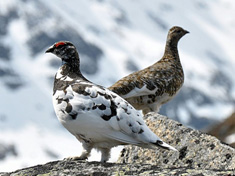
History and Authority
Willow Ptarmigan (Lagopus lagopus) and Rock Ptargmigan (Lagopus muta) are found throughout the province. The Willow Ptarmigan is a more sedentary species; the Rock Ptarmigan adopts a seasonal camouflage. Found primarily in barrens and high country, the partridge epitomizes the open wilderness. It is an arctic bird; the Burin and Avalon peninsulas may be the most southern, naturally occurring extremity for the bird’s range in North America.
The Newfoundland Pony: Provincial Heritage Animal
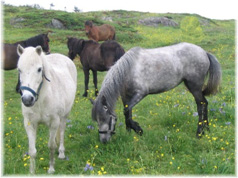
History and Authority
Designated by Order of the Minister of Forest Resources and Agrifoods 12 September 1997 under authority granted by SNL 1996 Chapter H-2.1 the Heritage Animals Act. The ministerial order identified the Newfoundland Pony Society as the group responsible for the promotion of this animal.
On 2 May 2012 the Animal Health and Protection Act came into force, replacing the Heritage Animals Act but making no substantial change to powers under the Act with respect to Heritage Animals.
The Woodland Caribou: Animal Mascot of the Royal Newfoundland Regiment
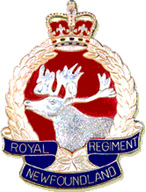
History and Authority
The Woodland Caribou, found throughout Newfoundland and Labrador, was adopted by members of the Royal Newfoundland Regiment as their animal mascot in 1914 at the outbreak of World War I.
Five life-size bronze caribou memorial statues were executed by sculptor Basil Gotto following World War I and installed at the following battlefields: Beaumont-Hamel; Masnieres, Monchy-le-Preux, and Gueudecourt in France, and Courtrai/Kortrijk in Belgium. A sixth caribou was installed at Bowring Park, St. John’s, the gift of Maj. William Howe Green, architect of Cabot Tower.
Labradorite: The Provincial Mineral
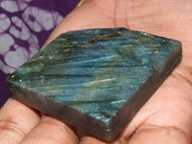
History and Authority
Declared Provincial Mineral in 1975.
A variant of feldspar, its principal base colour is blue with iridescent green gold, and brown.
Newfoundland and Labrador Tartan: Provincial Tartan
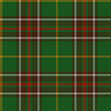
History and Authority
Officially registered in 1973 with the Court of Lord Lyon, King of Arms of Scotland. Its International Tartan Index Number is 1543.
Created in 1955 by St. John’s Water Street shopkeeper Samuel Wilansky to recognize the colours implied by The Ode to Newfoundland. The green represents the “pine clad hills”, the white represents snow, the brown represents iron, and the red represents the Royal Standard. It is commonly found in tourist souvenirs and in clothing products.
